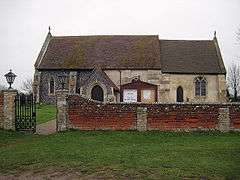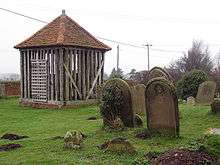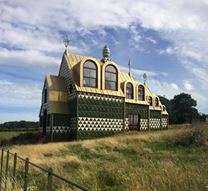Wrabness
Wrabness is a small village and civil parish near Manningtree, Essex, England. The village is located six miles (10 km) west of Harwich. Wrabness railway station is served by trains on the Mayflower Line. Wrabness had a population of approximately 400.
| Wrabness | |
|---|---|
 All Saints, Wrabness | |
 Wrabness Location within Essex | |
| Population | 401 (2011)[1] |
| OS grid reference | TM222417 |
| Civil parish |
|
| District | |
| Shire county | |
| Region | |
| Country | England |
| Sovereign state | United Kingdom |
| Post town | Manningtree |
| Postcode district | CO11 |
| Dialling code | 01255 |
| Police | Essex |
| Fire | Essex |
| Ambulance | East of England |
| UK Parliament | |
All Saints' Church

The oldest building in the village is All Saints' Church, which dates from around 1100. The church's bell tower collapsed in the seventeenth century, and the bell moved temporarily to a wooden bell cage in the church yard. The bell cage remains to this day.
The Mine Depot The largest enterprise and main employer at Wrabness was for many years (including the world wars) the Royal Navy Mine Depot, where thousands of mines were stored for laying in the North Sea. Men from the Depot won medals for defusing enemy mines and handling dangerous ammunition for the Navy at nearby Parkeston Quay. The site is today in civilian use.
Wrabness Nature Reserve
Wrabness Local Nature Reserve was designated in 1993.[2][3] It covers 52 acres (210,000 m2) on the banks of the River Stour estuary. The site was once a former mine depot established in 1921 by the Ministry of Defence. It was closed in 1963. Following closure, a number of planning applications were put forward (including an application for a prison in 1968 and 1989). The site was saved from closure when it was bought by Wrabness Nature Reserve Charitable Trust in 1992. The site has now been taken over by the Essex Wildlife Trust.
The reserve is an important wildlife site - owls, yellowhammers, whitethroats, turtle dove, song thrush, nightingales and bullfinches can be seen. There are also many wild plants such as corn mint, hairy buttercup, sea aster and ox-eye daisy.
There is good access with a hard-core path around the reserve making it accessible for pushchairs or with disabilities.
Grayson Perry's "Julie’s House"

In 2015 a conceptual holiday home was created by the artist Grayson Perry, working with FAT, and commissioned by the charity Living Architecture. It is known as "Julie’s House" or "A House for Essex", in homage to the "single mums in Dagenham, hairdressers in Colchester, and the landscape and history of Essex". The house is highly decorated incorporating rooftop ornaments, and overlooks the River Stour near the village.[4][5][6]
References
- "Parish population 2011". Retrieved 24 September 2015.
- "Wrabness". Local Nature Reserves. Natural England. Retrieved 2 August 2013.
- "Map of Wrabness". Local Nature Reserves. Natural England. Retrieved 2 August 2013.
- Oliver Wainwright (15 May 2015). "For Grayson Perry's Essex house, the only way was 'bonkers as possible'". The Guardian. Retrieved 18 May 2015.
- "Art fans flock to 'Grayson Perry house' in Essex". BBC. 27 February 2015. Retrieved 18 May 2015.
- Will Gompertz (16 May 2015). "Take a walk around the house that Grayson Perry designed (video)". BBC. Retrieved 18 May 2015.
External links
| Wikimedia Commons has media related to Wrabness. |